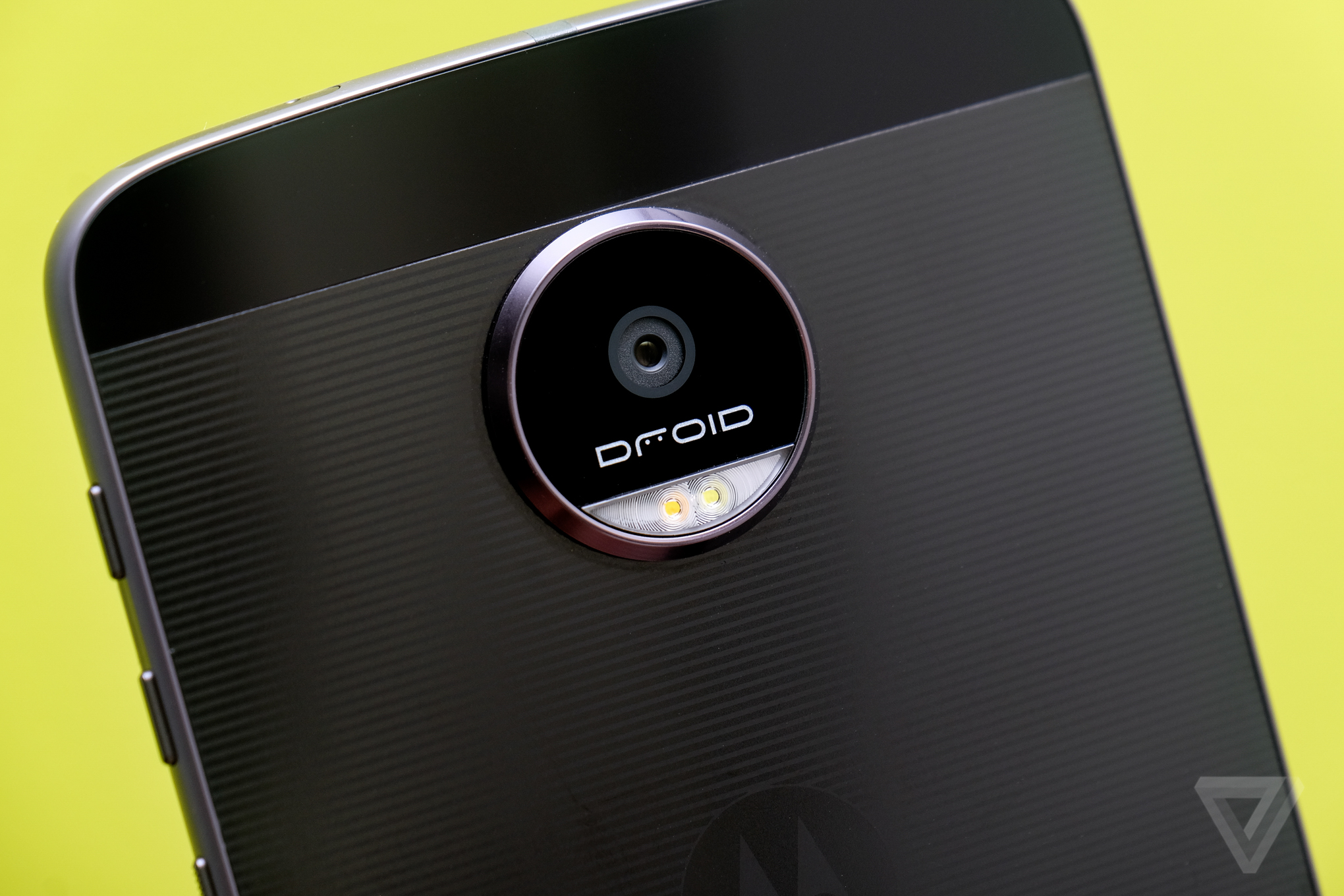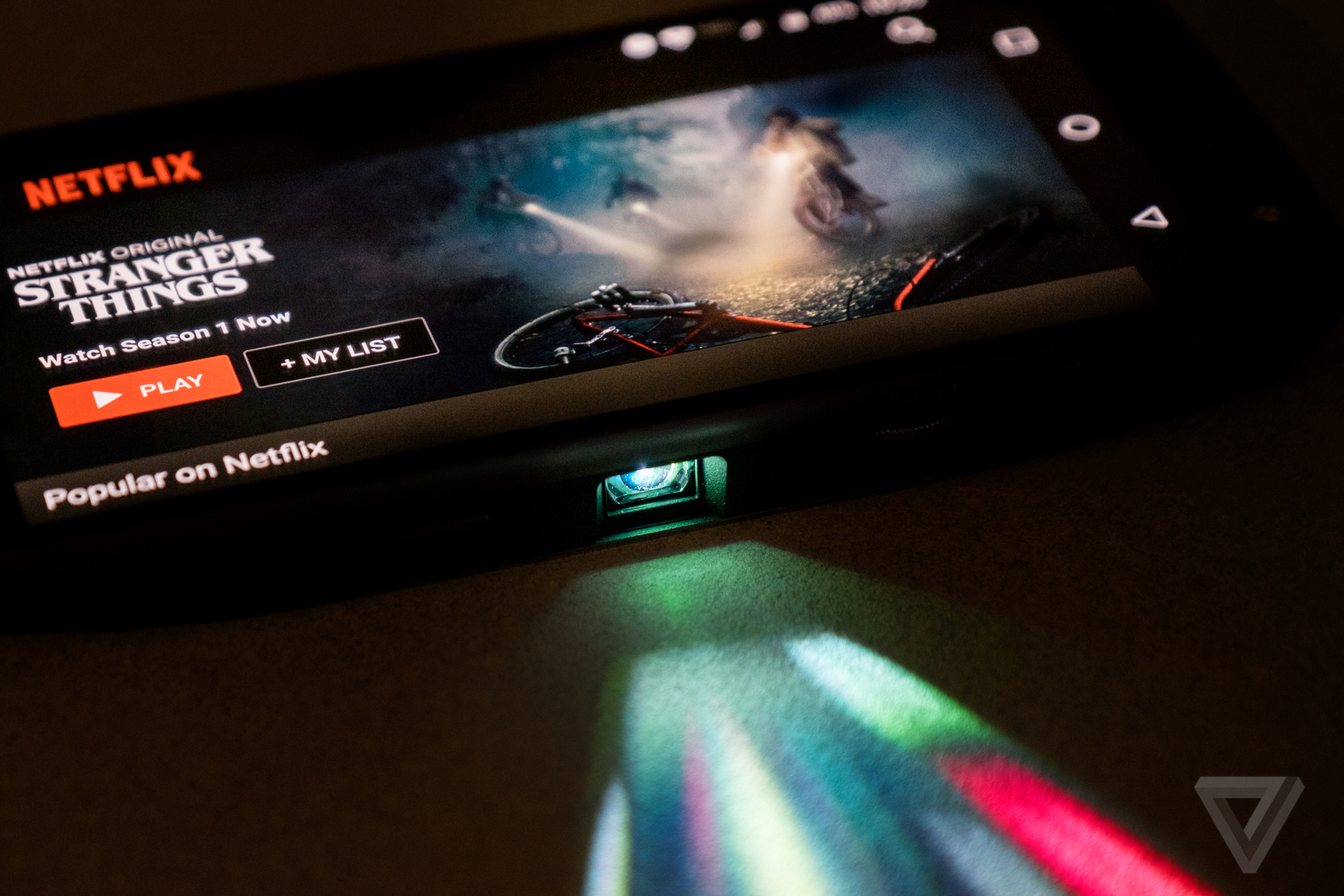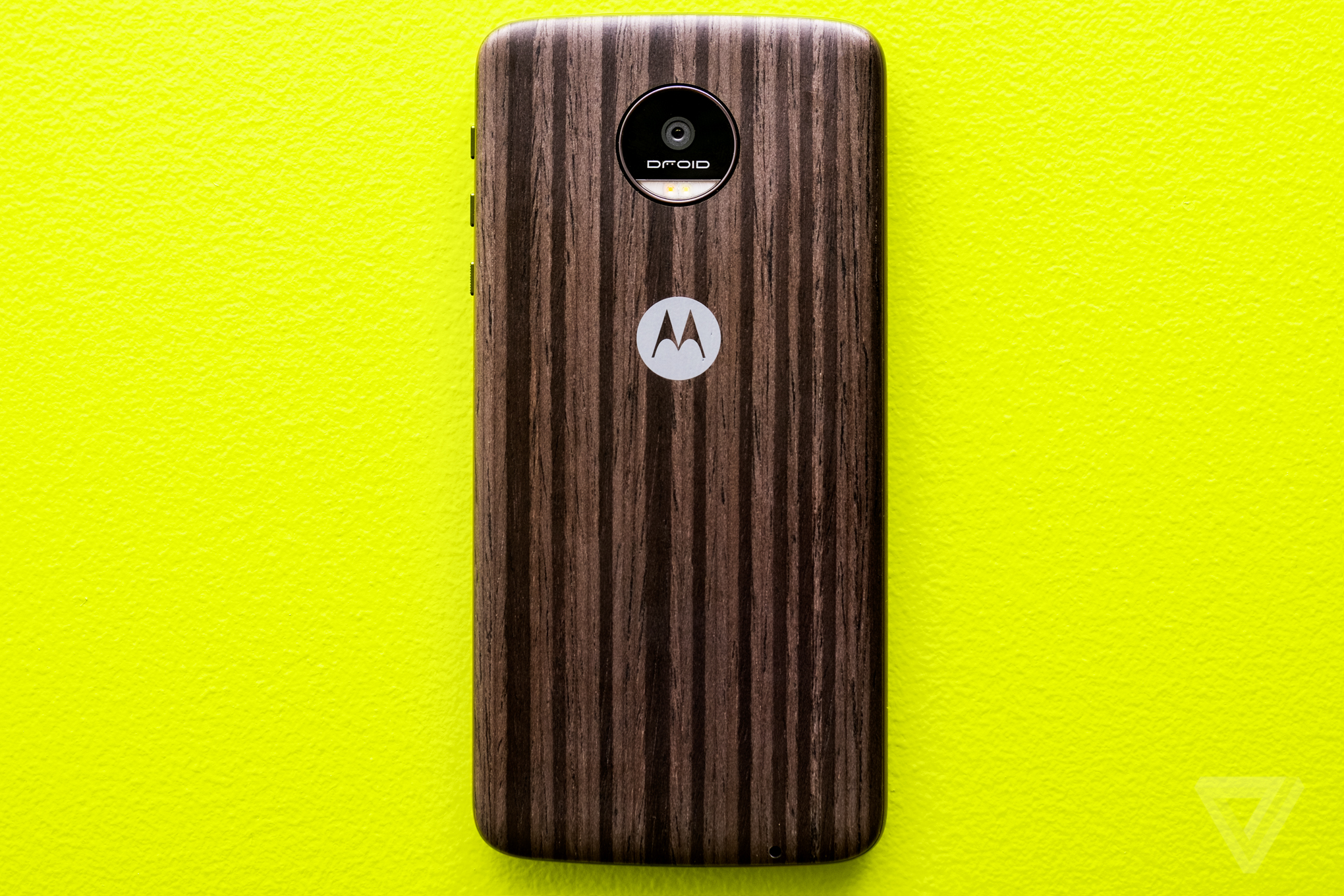Lenovo’s new Moto Z and Moto Z Force are the best test yet of whether a “modular” approach to smartphones can truly reinvent what these devices can be, beyond slabs of internet-connected glass. In reviewing them, I’ve been trying to figure out whether this futuristic dream makes sense, if it’s an underwhelming gimmick, or maybe modularity is just a fun thing somewhere in between.
I didn’t expect the answer: all of the above.
These two phones are coming to Verizon starting July 28th (preorders open today) as the latest Droids. And having that “Droid” brand attached to these particular Android phones, which let you attach and switch between snap-on components called Moto Mods, feels very appropriate to that robotic heritage. You can slap on a speaker, a battery pack, or even a projector! There are some very cool ideas here.
But can add-ons really make smartphones better than what you get out of the box? We saw LG give it a try with the G5; that phone let you slide out the bottom module and replace it with a camera grip or audiophile-grade headphone amp. But months later, the best thing about the G5’s "modularity" is the ability to swap out the phone’s battery. It wasn’t exactly a game changer. Then there’s Google’s Project Ara, which dreams bigger but remains rather far off from becoming a consumer product. The Moto Z Droid and Moto Z Force Droid are here now, though they don’t come cheap: the Z costs $624 and the Force is $720, each available to be split across 24 monthly payments. That’s what you’d pay for a Galaxy S7 or HTC 10 — and much more than the excellent OnePlus 3. So even before you start paying for the Moto Mods, these need to be excellent smartphones in their own right. And they are, but each for a different reason: one is ridiculously thin, the other surprisingly durable.

The Moto Z is incredibly thin — the thinnest premium smartphone ever made, according to Lenovo. It’s 5.19 millimeters (0.2 inches) deep, barely thicker than the USB-C port at the bottom and remarkably light in hand. My iPhone 6S looks chunky placed next to it. The much bulkier Moto Z Force builds its name on durability and longevity. It’s got a display that won’t crack or shatter no matter how many times you drop it, and a much bigger battery (3,500mAh) than the regular Z (2,600mAh).
Is a phone this incredibly thin worth the annoyance of no headphone jack?
In pushing these design boundaries, Lenovo made the decision to get rid of the headphone jack on both models. That means you’re stuck either going wireless with Bluetooth headphones or plugging in a wired pair with the included, easy-to-lose adapter. You can call it user-hostile and unnecessary, sure. My takeaway after a week of using the Moto Z is that it can be rather inconvenient, but not a complete deal-breaker. It’s form over function, but the form is incredible. I’ve really come to enjoy carrying something so svelte and light around. I wish I could tell you if the tradeoff is worth it, but honestly it’s going to come down to individual preference and your willingness to deal with the hassles of Bluetooth or dongles. And if you're using the adapter, forget about charging your phone at the same time; the Moto Z lacks wireless charging capabilities.
The look of these Moto phones is fresh and stands out from the competition, mostly owing to the massive camera bump on back and the collection of 16 gold pins at the bottom that allow the Moto Mods system to work. Both phones share the same metal-and-glass design; you’ve got Moto’s typical styling up front, but around back is something different. It’s a little iPhone 5ish with two pieces of glass and a long, pin-striped sheet of metal sandwiched in between. Opinions around The Verge office have swung both ways, but I like what Lenovo has done mostly because it’s different and a move away from machined aluminum and visible antenna lines.
The front of each phone features a fast fingerprint sensor (which doesn’t double as a home button, annoyingly), a 5.5-inch Quad HD AMOLED display, a 5-megapixel selfie camera, and a front-facing flash. The Moto Z has Gorilla Glass 4 protecting its display, like many other phones, but the Force’s screen is much different. It’s using the second-generation of Moto’s ShatterShield technology to guard against damage. The five-layer system has a protective plastic hardcoat on top, which scratches way easier than glass. But you can have Verizon swap it out if it gets too bad.

The nice thing is you don’t really lose out on display clarity and sharpness by choosing the Force and ShatterShield. It’s as bright and vivid as the glass-covered Z from any viewing angle. Lenovo has made a lot of progress since we first saw this drop-proof screen in last year’s Droid Turbo 2. The new ShatterShield display is guaranteed against cracking for four years, which is longer than most people are likely to own this phone. To be clear, the screen is what’s promised as shatterproof, not the rest of the phone. The metal sides of the phone will still get scuffed up and show damage from those drops. Neither phone is waterproof, but both are coated with a water repellant; Lenovo claims they’ll be fine if splashed or spilled on. Don’t drop them in the toilet or pool and you should be fine.
Both Droids share other traits, too: a Snapdragon 820 processor (which can run pretty warm in these phones), 4GB of RAM, and either 32GB or 64GB of storage, plus a microSD slot. There's only one loudspeaker in the earpiece, so that's a downgrade from the great stereo audio offered by last year's Moto X Pure Edition. They run Android 6.0 Marshmallow with Moto’s software improvements such as Moto Display — still the best approach to notifications on a smartphone, I think — and Moto Voice, which lets you access Google’s search assistant hands free.
As is often the case with Verizon phones, both devices come with a ton of bloatware. You’ve got Verizon’s usual suite of tools (visual voicemail, VZ Navigator, etc.) but also total spam like Juice Jam and Slotomania. It’s pretty shameful stuff when you’re talking about a phone this expensive. Thankfully you can disable almost everything, but even that’s a step you shouldn’t be forced to go through. Moto also has some proving to do when it comes to timely software updates; the company has slowed its pace dramatically over the last couple years, which is disappointing to see.
One big difference between the Moto Z and Z Force is the camera. The Z has a 13-megapixel sensor, and the Force ups that to 21 megapixels. Both have optical image stabilization, laser autofocus, a bright f/1.8 aperture, and capture pixels at the same size (1.12um). Lenovo and the Moto team claim to have done a lot of work on the Force’s camera in particular, and it also has phase detection autofocus, which the regular Z doesn’t. In my tests, both cameras were decent performers. The camera software is very fast to shoot, with strong results in good lighting and respectable performance in lower light. Images can be a little oversaturated at times, and the image processing / noise reduction can be heavy handed, too. Overall, they’re fine cameras, but fall short of the very high standards set by Samsung’s Galaxy S7.
That big camera bump is there for more than one reason, though. It’s an easy visual alignment point for the Moto Mods that are meant to be the Moto Z’s biggest selling point. At launch, you’ve got several to choose from: there are style covers that change the look and texture of the phone. Whenever you put one of these on, the back of the Moto Z becomes completely uniform; no more camera bump. I went back and forth between using the wood style cover included in the box and carrying around the Moto Z "naked." As much as I enjoyed the Moto Z’s thinness, I constantly felt a need to be delicate with the phone without a cover attached. (That’s not something you’ve really got to worry about with the Force.)
Move up from the style covers and Moto Mods start to get interesting, but very expensive. There’s a $79.99 JBL Soundboost speaker that attaches to the Moto Z and pumps out audio way better than you’d typically get from any smartphone. It’s even got a built-in kickstand for setting on a table. I can see this being useful if you’re traveling, perhaps, but I have no idea why you’d buy it over a portable Bluetooth speaker like the UE Roll.
The first moto mods are expensive and you don't really need any of them
The battery cases from Incipio, Tumi, and Kate Spade make a little more practical sense. They range in price from $60 to $90, though, and only offer a capacity of 2,200mAh. That’s not enough to get you from zero back to 100 percent; you’d be more likely use these to top off when you’re down to a 50 or 60 percent charge or to just make it through the rest of the day until you can plug in. I wouldn’t buy any of them, though, because the TurboPower charging in both Droids is very, very quick to refill the battery. Just don't believe Lenovo's nonsensical claim that plugging in for 15 minutes will get you 8 hours of battery. Not quite.
You might think that because of its thin design, the Moto Z would have terrible battery life, but it really doesn’t. At least, not to extent that it’s a problem. If you’re a power user, you might need a recharge before day’s end. But again, the included Moto charger gets both phones going again in a hurry. And with the Force? Forget about it. Who needs a battery pack for a phone that easily sails through a day of heavy use?

And then there’s the Moto Insta-Share projector. Snap it onto the Moto Z, hit the power button, and it’ll beam out an image up to 70 inches on any wall. This is probably the Moto Mod with the biggest "wow" factor. Everyone that I demonstrated it to was blown away — mostly by the concept and less so the actual image quality. A projector that latches onto your phone and turns any wall into your personal Netflix or YouTube movie screen is just a cool idea. The Insta-Share projector goes up to 50 lumens (which isn't all that bright) and you’re limited to 480p resolution, a harsh change when you’re coming from a Quad HD smartphone display. Colors can look a bit washed out, too. Here’s the bigger problem though: it’s $300. I don’t understand where that price comes from, nor do I suspect many people will pay nearly half the price of the Moto Z for any Moto Mod. The only way this thing is going to sell is if Verizon offers some kind of generous discount on your first Moto Mod.
To Moto’s credit, all of these add-ons just work without any fuss. There are no settings to worry about and no annoying pairing process to go through. Attach a Moto Mod, you’ll see a brief tutorial on how to use it (often a single screen), and that’s it. The fancier Moto Mods all have their own internal batteries. They’ll charge up when attached to the phone with a USB-C cable plugged in, and the speaker and projector can also be charged independent of the phone; they’ve got their own USB-C jacks built-in.
But as cool as the Moto Mods might be, I found myself constantly wondering: why not buy a gadget that works with multiple devices instead of the one dependent on a single phone? There’s some convenience in having them attached to the thing already in my pocket, but not quite enough to justify being locked in to using everything only with the Moto Z. Lenovo has promised that these Mods will be fully supported by future successors to the Moto Z, but buying into this whole thing still requires an enormous amount of faith in that promise and in this company. I wouldn’t call you crazy for getting the speaker, but the $300 projector? Just… no way.

Whenever you snap on these Moto Mods, you get a visceral feeling of "Yes, this is right, this is how extending a phone should work." The approach is dead on. Who doesn’t like magnets? The Mods latch on securely and never fall off unless you drop the whole phone. And Mods enjoy much deeper integration with the phone’s core than some rando accessory. In that respect, Moto deserves some kudos for pushing the concept forward.
What’s missing is that one must-have Moto Mod. These first few are by no means essential. Others are coming, though. Lenovo is working on more due this calendar year, and developers can dream up and build their own by joining the Moto Mods developer program. Lenovo and Verizon will need to sell a lot of phones before that happens, though.
In the meantime, the Moto Z Droid and Moto Z Force Droid are both good, premium Android flagships with standout features: one of them is ridiculously thin, the other super strong. Between the two, I recommend the regular Moto Z over the Force. For me, the thinner profile wins out over the toughened display and big battery.
But this is a pretty bad time to buy a new smartphone, with the Galaxy Note 7, a new iPhone, and new Nexus devices all slated to arrive within the next few months. And truthfully, these phones aren't any better than existing options from Samsung, Huawei, HTC, or LG. If Lenovo's goal was to stray from the pack and do something a little different, it succeeded. The Moto Z and Moto Mods are unique. They're fun. They're a little gimmicky. But they're definitely different.
Photography by Chris Welch
Video by Mark Linsangan and Phil Esposito
:format(webp)/cdn.vox-cdn.com/uploads/chorus_asset/file/12432973/cwelch_160720_1145_0004.0.0.0.jpg)
:format(webp)/cdn.vox-cdn.com/uploads/chorus_asset/file/12432973/cwelch_160720_1145_0004.0.0.0.jpg)
Share this story